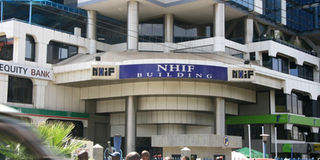Packages could be what the doctor ordered

The NHIF Building in Nairobi. A utilisation report on surgery released by the public insurer early this month puts expenditure on major and minor surgeries at Sh3.62 billion this year, up from Sh2.09 billion in the 2016/7 financial year. PHOTO | FILE | NATION MEDIA GROUP
What you need to know:
- I have encountered these and other cases in the course of my work as a health journalist.
- The NHIF package was rolled out in October 2016, and covers the cost of what has been classified as major, minor and specialised surgeries.
- The limits, NHIF says, are subject to the level of the hospital and the procedure.
Until a few years ago, David Obote was a public service vehicle driver plying his trade between Busia and Kisumu towns, which he had done for two decades, and was bringing up his five children with relative ease.
But that changed when David began feeling unwell frequently before he was diagnosed with diabetes.
He became a frequent visitor to the hospital and was less seen on the road.
Soon, he told a reporter recently, his toes started swelling one after the other.
With the cumulative pus, his left leg began to smell.
AMPUTATION
Doctors recommended amputation of the affected leg to prevent the disease from spreading to rest of the body.
Though he no longer worked and his finances were low, he was admitted and operated on.
In neighbouring Kakamega, Peter Kirui was involved in a road accident that put him in hospital — at Kakamega General Hospital and Moi Teaching and Referral Hospital in Eldoret — for a month. He underwent surgery. By the time he was discharged, Peter’s bill was Sh250,000.
He didn’t have the money. But he returned home.
Hyline Nyaboke, 37, has been living with intermittent back pains for half of her life.
The mother of two, who sells vegetables in Narok, had struggled with even simple domestic chores for 15 years.
PAINKILLERS
Painkillers would lessen her suffering — until one morning a month ago, when she felt a “sharp pain” that made movement impossible.
She was taken to hospital and admitted.
Doctors performed surgery and Hyline has not felt the pain for three weeks.
That cost Sh80,000, which she did not have. But the bill was cleared.
I have encountered these and other cases in the course of my work as a health journalist.
The financial situation of these people means that without help, they would have been condemned to living with — or dying from — their conditions.
NHIF PACKAGE
David, Peter and Hyline are beneficiaries of the National Hospital Insurance Fund Surgical Benefit package.
According to NHIF records, the package was rolled out in October 2016, and covers the cost of what has been classified as major, minor and specialised surgeries up to Sh500,000. Cover for major surgeries ranges from Sh80,000 to Sh130,000 with the maximum for specialised ones at Sh500,000.
The limits, NHIF says, are subject to the level of the hospital and the procedure.
SURGERY REPORT
A utilisation report on surgery released by the public insurer early this month puts expenditure on major and minor surgeries at Sh3.62 billion this year, up from Sh2.09 billion in the 2016/7 financial year.
Specialised surgeries took up Sh548 million in 2017/8, from Sh274 million in 2016/7. Since inception, the NHIF has spent Sh12 billion on surgeries.
Other than surgeries, the Fund has a number of other packages that are offered through the Supa Cover, which costs Sh500 per month to cover a principal member and his or her dependents.
However, more innovation is required to increase healthcare access for Kenyans, particularly those who cannot afford expensive medical procedures.
Such are the expectations of Kenyans, with the promise of universal health coverage in the ‘Big Four’ agenda.
Ms Benyawa is a freelance journalist. [email protected]





